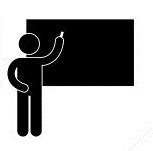 Scientists at the University of Copenhagen are bringing multi-touch wall-sized displays back into the limelight with their recent publication “Proximity and Physical Navigation in Collaborative Work With a Multi-Touch Wall-Display.” The focus of the study is to analyze how groups of people use the displays to solve analytical problems. While significant work has been done in analyzing table-top displays, wall-displays are a relatively new horizon.
Scientists at the University of Copenhagen are bringing multi-touch wall-sized displays back into the limelight with their recent publication “Proximity and Physical Navigation in Collaborative Work With a Multi-Touch Wall-Display.” The focus of the study is to analyze how groups of people use the displays to solve analytical problems. While significant work has been done in analyzing table-top displays, wall-displays are a relatively new horizon.
The study was done by creating a large 7680×3240 pixel, 9’ by 4’ display. 12 projectors were used, together with six DSI (Diffuse Surface Illumination) touch surfaces to build the wall touch-screen. Participants were given a well-known analytical study called the “Stegosaurus” – a mystery to find a hidden weapons smuggling conspiracy plot among a small town’s news archive. As the participants used the touchscreen, head-tracking equipment analyzed their position relative to the board and each other.
The results showed that, compared to table displays, users of wall-displays felt more comfortable getting close to other users, sharing information, and collaborating. While tabletop displays often worked best when each person had their own “territory” on the table, wall displays instead inspired collaboration. Users stayed close together, within around three feet of each other, for 74% of the time. Overall, the study showed that wall-displays offer many more exciting new boundaries for collaboration than tabletop-displays, which had been launched with much fanfare in 2008, and then fizzled shortly thereafter.
Still, with all the promise, there were a few untested variables that would have made the study more interesting. The researchers didn’t measure the actual success of the participants’ analysis. It would be interesting to learn whether the participants simply moved around and talked more while interacting with the wall displays, or if they actually accomplished better work. Similar to real-world meetings, it’s often not the quantity of words and movements that define meeting productivity, but rather the action-items and decisions that are implemented.
In addition to the productivity analysis, it would be interesting to contrast the wall-display with both tabletop-displays and a folder of physical files. If the wall displays don’t actually improve productivity compared to traditional paper, then they amount to little more than a fun new gadget for the executive team. While redoing the study, it would also be useful to use the same set of participants throughout all three scenarios. In the current wall-display study, the participants were all very familiar with each other beforehand, which may have not been the case in the contrasted tabletop-display studies.
As noted by the paper, the most exciting next steps for wall-displays are with the user interface. Although participants had a gigantic digital whiteboard, there was no way for them to draw on the screen. It would be fascinating to see how participants would interact with the board if they had the capability to mark items, draw, and more effectively reproduce the same actions they could take in real life. Although drawing with fingers is the current primary method for most touch displays, it would also be interesting to offer participants a “digital marker” – providing better accuracy in drawing and a more immersive experience.
Altogether, multi-touch wall displays are an exciting new frontier for human-computer interaction, and hopefully it will only be a matter of time before they work their way into our homes and daily lives.
Written by Andrew Palczewski
About the Author
Andrew Palczewski is CEO of apHarmony, a Chicago software development company. He holds a Master's degree in Computer Engineering from the University of Illinois at Urbana-Champaign and has over ten years' experience in managing development of software projects.
Google+







